Infusion therapy for anemia! If you’re always tired, feeling weak, and short of breath, anemia might be the reason. Iron deficiency anemia happens when you don’t have enough iron. Infusion therapy for anemia can help! This guide will explain what it is, why doctors use it, and if it might be a good option for you.
Learn about infusion therapy for anemia – a fast way to boost iron levels. Discover if it’s right for you, the procedure, side effects, and more.
What is Infusion Therapy for Anemia?
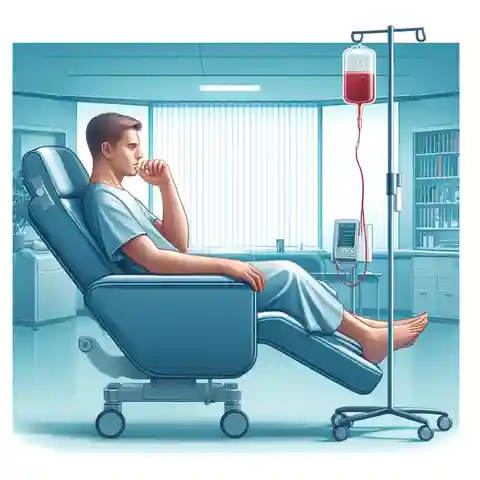
A medical illustration depicting a male patient receiving infusion therapy for anemia
Infusions are like a supercharged way to get iron directly into your blood. A special kind of liquid iron goes through a tiny tube (called an IV) and into your vein.
Why You Need Infusion Therapy?
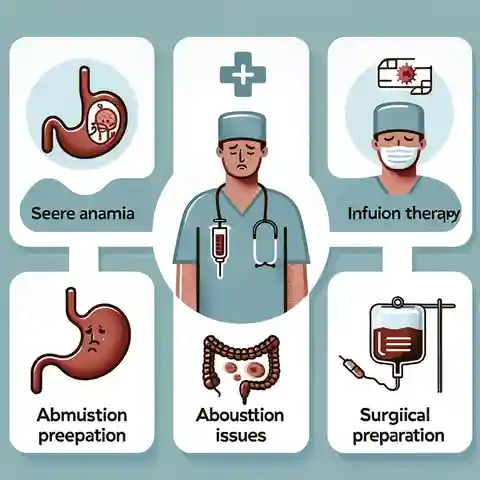
Infusion Therapy for Anemia – An informative image illustrating the reasons why doctors might recommend infusion therapy for anemia
Your doctor might recommend infusion therapy if:
- Severe anemia: Your anemia is bad and making you feel awful. Infusions get iron into your system fast, so you might start feeling better sooner.
- Absorption Problems: Certain health problems make it hard for your body to take in iron from pills. Infusions skip this step – the iron goes directly into your blood.
- Ongoing blood loss: Things like heavy periods or internal bleeding make it hard to keep your iron levels up. Infusions can help you catch up.
- Getting Ready for Surgery: Iron infusions pump up your iron stores before surgery. This can lower the chance of needing blood during the operation and help you heal quicker.
Different Types of Infusion Therapy for Anemia
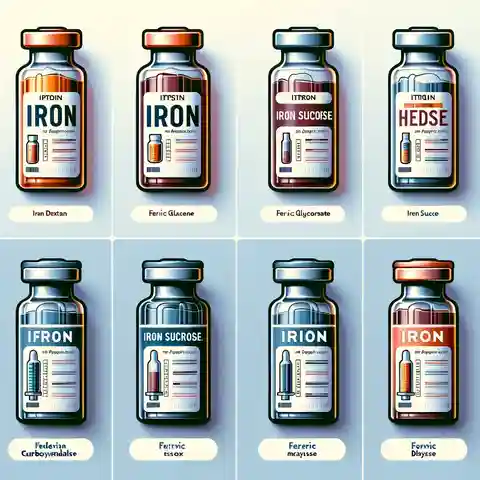
Infusion Therapy for Anemia – A comparative image of the different types of iron infusions available for anemia treatment, such as iron dextran, ferric gluconate
The main types of iron infusions are:
- Iron dextran: A traditional and less expensive form of IV iron. It usually requires only a single infusion but carries a slightly higher risk of allergic reactions than newer formulations.
- Ferric gluconate: This form is frequently used for people receiving dialysis for kidney disease. It’s given in multiple smaller doses.
- Iron sucrose: Similar to ferric gluconate, it’s administered in several smaller doses. It’s a good option if you have allergies to other medications.
- Ferric carboxymaltose: One of the newer formulations, it’s given in just one or two infusions. It’s been shown to be safe for use in various settings.
The specific type of iron infusion your doctor recommends will depend on several factors, including:
- Severity of your anemia: How low your iron levels are
- Other health conditions: If you have kidney problems, allergies, or other medical concerns
- Insurance coverage: Some types of iron infusions may be more expensive
It’s best to discuss the pros and cons of each type of iron infusion with your doctor. They can help you choose the most suitable one based on your individual needs and health profile.
Who is a good candidate for infusion therapy for anemia?
If you have anemia caused by low iron, infusion therapy might be a helpful treatment. Here’s who often makes a good candidate:
Individuals who might be good candidates:
- Really Low Iron: Your anemia is severe, and you have noticeable symptoms.
- Trouble with Iron Pills: They give you an upset stomach, or your body has problems absorbing them.
- Losing Blood Regularly: Heavy periods or internal bleeding make it hard to keep iron levels up.
- Some Health Problems:
- Kidney disease (especially if you’re on dialysis)
- Inflammatory bowel diseases like Crohn’s or colitis
- Heart failure
- Before Surgery: To get your iron up fast and lower the chance of needing blood.
Individuals who might NOT be good candidates:
- Mild or Moderate Anemia: Pills and changing your diet might be enough.
- Current Infection: Doctors usually treat the infection first.
- Hemochromatosis: This is when your body holds onto too much iron.
- Bad Allergies: Some types of iron infusions might not be safe for you.
Your doctor is the best judge! They’ll look at your whole health picture to decide if infusion therapy would be a good choice for you.
How Iron Infusion Therapy Works
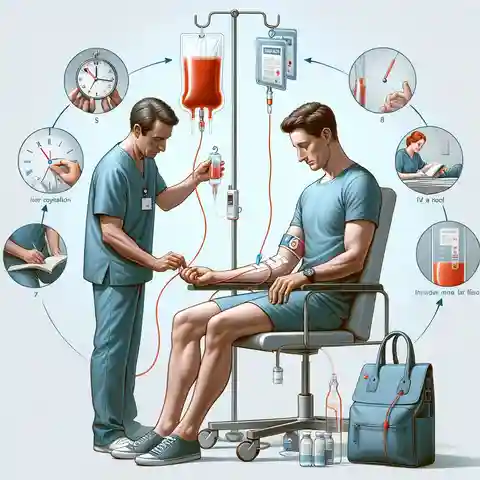
An educational image detailing the step-by-step process of iron infusion therapy for anemia, focusing on a male patient
Iron infusions are pretty straightforward. Here’s the breakdown:
- The Iron Boost: It’s a special kind of liquid iron that goes straight into your blood through a tiny tube (an IV). This is way faster than taking iron pills!
- Where It Goes: A nurse puts a small needle into a vein, usually in your arm. The iron drips slowly from a bag, through the IV, and into your blood.
- Rebuilding Your Supply: Now, the iron is in your bloodstream, ready to help your body make healthy red blood cells to carry oxygen.
- Timing: An iron infusion takes a few hours. Kick back, read, or even nap while it works!
Why Infusions Are Different from Iron Pills
- Super Speedy: Infusions fix low iron fast, especially if your anemia is bad.
- No Tummy Troubles: If your stomach has a hard time with iron pills, infusions skip that whole part.
- Sometimes Easier: One or two infusions can be simpler than taking pills every single day.
What About Side Effects?
It’s good to know that iron infusions can sometimes have side effects. Most are mild and go away on their own. Common ones include:
- Weird metallic taste for a bit
- Headache
- Feeling a little sick to your stomach
Less Common, But Important
It’s rare, but some people have allergic reactions to the iron. Signs can be:
- Hives or a rash
- Hard time breathing
- Chest pain
- Low blood pressure
Don’t worry, your doctor and nurses will watch you carefully to catch any problems quickly.
Is Infusion Therapy Right for Me?
The best way to know for sure is to have a conversation with your doctor. Here’s why:
They understand your unique situation
Your doctor knows your medical history, any current health conditions, and the specifics of your anemia. This information is crucial for deciding if infusion therapy is safe and appropriate.
They can weigh the pros and cons
Your doctor can explain the benefits of infusion therapy while also discussing any potential risks or side effects in relation to your individual case.
They can explore other options
If infusion therapy isn’t the best fit, your doctor can discuss alternatives like iron supplements, dietary changes, or addressing underlying causes.
Your doctor is your partner in health! They’ll work with you to find the most effective and personalized treatment plan for your anemia.
Alternatives to infusion therapy for anemia
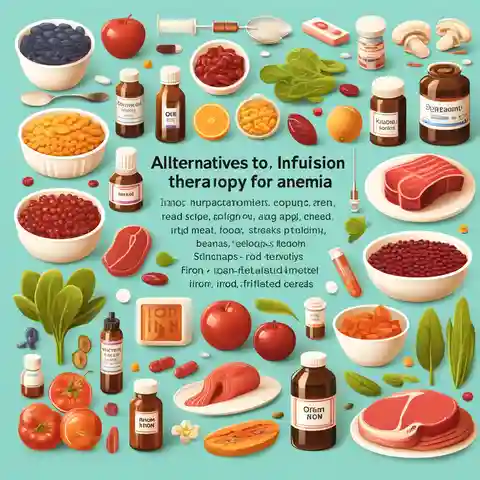
An informative image showcasing alternatives to infusion therapy for anemia, including oral iron supplements and dietary changes
Here’s a look at some alternatives to infusion therapy for anemia, along with when they might be appropriate:
Oral Iron Supplements
These are often the first line of treatment for iron deficiency anemia. They come in various forms (pills, capsules, liquids) and strengths. Your doctor can help you find the right one. They’re a good option if your anemia is mild to moderate.
Dietary Changes
Eating iron-rich foods can help boost your iron levels. Good sources include:
- Red meat
- Dark, leafy greens like spinach
- Beans and lentils
- Iron-fortified cereals
Treating the Underlying Cause
Sometimes, anemia is caused by something other than low iron. Treating the primary issue is important. This could include:
- Medications for heavy menstrual bleeding
- Finding the source of blood loss (like a stomach ulcer)
- Treating conditions like inflammatory bowel disease
When Alternatives Might Be Better
- Mild Anemia: Unless there are other concerns, pills and diet changes might be enough.
- No Urgent Need: If your anemia isn’t severe, you and your doctor might have time to try other approaches first.
Feeling Better: Results of Infusion Therapy
Iron infusions can make a big difference! Here’s what you might notice:
- More energy: Say goodbye to feeling constantly tired.
- Less fatigue: You might have more pep in your step.
- Healthy glow: Your pale skin might regain its color.
Your doctor will check your blood tests to see how much your iron levels have improved. It might take some time to feel the full effect, but many people notice a difference pretty quickly.
The Infusion Experience
Here’s a quick breakdown of what to expect:
- Before: You’ll talk to your doctor and have some bloodwork done.
- During: You’ll relax in a comfortable chair while the iron solution is slowly given through an IV. This can take a few hours.
- After: You can usually go about your day. Your doctor might advise you to watch for any unusual side effects and let them know if they occur.
Each clinic might have slightly different procedures, so your doctor’s office will give you specific instructions for your infusion day.
Finding the Right Place for Infusion Therapy
Where can you get iron infusions for anemia? Here are the most common options:
- Your Doctor’s Office: Some doctors, especially blood specialists, can do infusions right in their office.
- Infusion Centers: These centers focus on giving treatments through an IV, like iron infusions.
- Hospitals: Some hospitals have special infusion clinics or offer them if you’re staying as a patient.
Questions to Ask a Potential Provider
It’s smart to ask potential doctors or clinics these questions:
- How Often Do You Do This? Find out how much experience they have with iron infusions.
- Which Type Is Right For Me? There are a few kinds of iron infusions; ask which they use and why.
- What Happens After? How will they check if the infusion is working and watch for side effects?
- Will My Insurance Cover It? Get clear on costs before you start treatment.
Where to Look for Help:
- Ask Your Doctor: They might have good recommendations.
- Call Your Insurance: They have a list of places that take your plan.
- Search Online: Some websites help you find doctors or centers that offer specific treatments.
Important: Feeling good about where you get your infusion is key! Choose a place you trust.
FAQs About Infusion Therapy for Anemia
How long does an iron infusion take?
The infusion itself usually takes a few hours. However, plan for a longer appointment overall as there is often pre-infusion preparation and observation time afterward.
Is infusion therapy for anemia painful?
Most people experience minimal discomfort. The initial needle insertion to place the IV is similar to having blood drawn. You might feel some temporary coolness as the iron solution enters your vein.
How will I know if infusion therapy is working?
Your doctor will monitor your iron levels with blood tests. You shouldn’t expect to feel dramatically different overnight, but many people notice improved energy and less fatigue within a few weeks of treatment.
Are there long-term side effects of iron infusions?
Iron infusions are generally considered safe. Long-term side effects are rare, but your doctor can discuss specific risks based on your medical history.
Can I drive myself home after an iron infusion?
Yes, you can usually drive yourself. Unless you experience any unusual side effects, you should be able to resume normal activities immediately.
How many iron infusions will I need?
This depends on the severity of your anemia and how your body responds. Your doctor will develop a personalized treatment plan that might involve one or a series of infusions.
Conclusion
Anemia can seriously impact your life. If you’re struggling, don’t hesitate to talk to your doctor about infusion therapy for anemia. It might be the key to feeling energized and healthy again! Remember, your doctor is your best resource for personalized advice on managing anemia.


